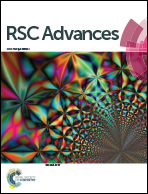Regio- and diastereoselectivity of the 1,3-dipolar cycloaddition of α-aryl nitrone with methacrolein. A theoretical investigation†
Abstract
The mechanism, regio- and diastereoselectivity of the 1,3-dipolar cycloaddition of N-iso-propyl,α-(4-trifluoromethyl)-phenyl nitrone with methacrolein yielding the isoxazolidine cycloadduct [V. Bãdoiu, E. P. Kündig, Org. Biomol. Chem., 2012, 10, 114] has been studied at the B3LYP/6-31G(d) level of theory. The two conformations s-cis and s-trans of methacrolein are considered in the cyclisation modes and all the possible regio-(ortho/meta) and stereo-(endo/exo) isomeric channels to provide the different diastereoisomers were thoroughly investigated. The free activation enthalpies, calculated with the MPW1B95/6-31G(d) method, in dichloromethane show that the meta-endo channel corresponding to the cyclisation mode between the nitrone and the s-cis methacrolein giving the RR/SS diastereoisomers is the most favoured reaction channel as expected experimentally. Intrinsic reaction coordinate (IRC) calculations and the topological analysis of the electron localization function (ELF) of some relevant points of the IRC curve show that the meta-endo favoured channel takes place via a one-step non-concerted mechanism. Charge transfer calculations performed in the transition states in combination with the calculation of DFT-based reactivity indices of the reactants reveal a low polar character of the studied reaction.


 Please wait while we load your content...
Please wait while we load your content...